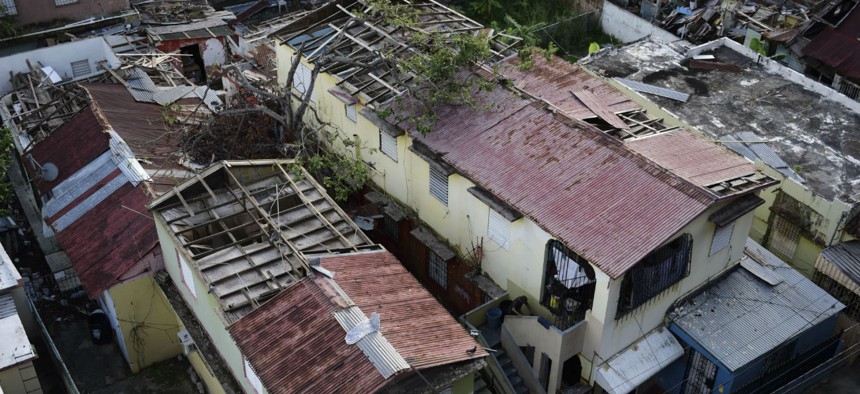HHS Lacked Adequate Staffing in 2017 Hurricane Responses, Watchdog Finds
Coordination with other agencies and patient tracking were also problems.
During the 2017 record-breaking hurricane season, the Health and Human Services Department lacked in sufficient staff and failed to track patient evaluations and coordinate with partner agencies. These issues could negatively affect future large-scale disaster recoveries if not dealt with, according to a watchdog.
“While the scale, location, and timing of these storms complicated response efforts, the deficiencies [the Government Accountability Office] identified were in many cases a function of preparedness policies, or lack thereof,” the report released on Friday stated.
GAO looked at how HHS’s Assistant Secretary for Preparedness and Response Office responded to hurricanes Irma and Maria, which hit the U.S. Virgin Islands and Puerto Rico within two weeks of each other in September 2017 and were both Category 5 storms. While the Federal Emergency Management Agency leads the overall federal response to emergencies, under the National Response Framework, the HHS office is in charge of coordinating federal assistance to bolster state and local resources following a public health-related disaster. HHS deployed more than 4,800 federal personnel—both full time and intermittent—to help with hurricane response from August 2017 to November 2017.
Auditors found that the Preparedness and Response office had a limited and rotating staff of liaison officials at the emergency operations centers in the Virgin Islands. “This limited ASPR’s leadership of the response and put undue resource strain on other responders, according to FEMA and territory health officials,” GAO said. For example, FEMA officials told GAO that finding and relaying patients's medical information was a time-consuming process due to the rotating officials.
GAO also found that following Hurricane Irma, the Preparedness and Response office did not sufficiently track patients who were evacuated from the Virgin Islands to Puerto Rico through the National Disaster Medical System. This system is operated by HHS, the Veterans Affairs Department, the Homeland Security Department and the Defense Department in support of state, local and tribal authorities following a disaster and is staffed by intermittent federal employees. Unlike other types of recovery officials, HHS did not pre-deploy the National Disaster Medical System staff, which compromised the tracking system, according to GAO.
“Of the approximately 800 [National Disaster Medical System] patient evacuations during the response to Hurricanes Irma and Maria, [HHS] could not readily provide us with the final status of approximately 200 of these patients,” GAO stated. “Officials could not determine if the patients were appropriately discharged and returned back to the U.S. Virgin Islands, left the system against medical advice or were otherwise unaccounted for.”
Limited focus on chronic and primary care needs for individuals in isolated locations was another issue. This was “greatly needed, given that many people, especially the elderly, could not easily access hospitals,” GAO stated. It reported that the HHS office was operating under the false assumptions that individuals including those in mountainous regions, could get to hospitals on their own and that smaller communities could help each other out. Specifically, in Puerto Rico, individuals sought care at federally qualified health centers, which are community-based organizations that provide primary care regardless of ability to pay, because they couldn’t travel to hospitals.
Lastly, the watchdog reported there was a “misalignment” between the HHS unit’s understanding of the support agencies (such as Defense, Homeland Security and Veterans Affairs) and the functions they were actually able to provide. As a result, some resources were not used efficiently and some agencies could not meet Assistant Secretary for Preparedness and Response’s needs.
For example, in one situation the VA and the HHS office had “conflicting expectations” on who was running shelter operations and who was running medical operations. In addition, the watchdog found that the Preparedness and Response office was extremely reliant on Defense, which provided much of the initial support following the hurricanes. GAO found the HHS office does not have a response strategy in the event that the Defense Department is unable to fully assist following a disaster.
Assistant Secretary for Preparedness and Response and its support agencies served almost 16,000 patients in Puerto Rico and almost 2,000 patients in the U.S. Virgin Islands in about four weeks after Hurricane Maria, GAO said. The population of Puerto Rico is about 3.3 million and that of the Virgin Islands is approximately 107,000, according to GAO.
Upon completing the audit that consisted of documentation review, interviews and site visits from June 2018 to September 2019, GAO acknowledged the progress the HHS office has been making. However, the watchdog made seven recommendations on how to further improve; HHS agreed with all but two.
Department officials did not agree that HHS should revise its incident response plan to include strategies for isolated areas because, while ASPR has a federal plan, each state and locality is responsible for its own plans, auditors said. Also, HHS did not agree that it should create an inventory to identify the abilities and limitations of the support agencies. Such an outline would become obsolete quickly, officials argued.




